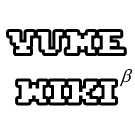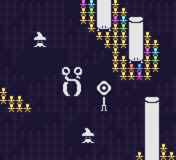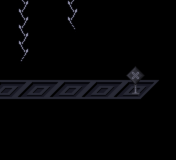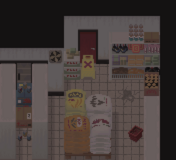(Draft content contribution page. I wrote this predominantly so that I would be able to link to "open connections" and "closed connections" in articles.) |
m (Grammar) |
||
| Line 6: | Line 6: | ||
Based on the functionality of the RPG Maker 2003 engine the game uses, the Collective Unconscious development staff delineate the individuals creating content for the game into two categories: contributors and developers. | Based on the functionality of the RPG Maker 2003 engine the game uses, the Collective Unconscious development staff delineate the individuals creating content for the game into two categories: contributors and developers. | ||
'''Contributors''' do not have access to the development build, but they are able to freely add certain assets to the game's repository, such as music, sound effects, pictures, and panoramic backgrounds, that do not require entries to be reserved in the game's database. Contributors do not require any prior experience with programming or with RPG Maker 2003. This also means that contributors do not have the ability to implement any assets they create into the game itself; while contributors can simply choose to leave these assets in the repository for the use of any developer, contributors are encouraged to work together with developers if they are interested their assets being included in an update to Collective Unconscious. | '''Contributors''' do not have access to the development build, but they are able to freely add certain assets to the game's repository, such as music, sound effects, pictures, and panoramic backgrounds, that do not require entries to be reserved in the game's database. Contributors do not require any prior experience with programming or with RPG Maker 2003. This also means that contributors do not have the ability to implement any assets they create into the game itself; while contributors can simply choose to leave these assets in the repository for the use of any developer, contributors are encouraged to work together with developers if they are interested in their assets being included in an update to Collective Unconscious. | ||
'''Developers''' are given access to the development build and are responsible for detailing and programming maps for the game, as well as initializing assets such as tilesets and animations. The activities that developers are responsible for require ID numbers in the game's database to be reserved in order to avoid conflicts between content with duplicate ID numbers. As developers are granted additional privileges and responsibilities, prospective developers undergo greater scrutiny, and they are required to apply with descriptions of their skills and examples of their work. | '''Developers''' are given access to the development build and are responsible for detailing and programming maps for the game, as well as initializing assets such as tilesets and animations. The activities that developers are responsible for require ID numbers in the game's database to be reserved in order to avoid conflicts between content with duplicate ID numbers. As developers are granted additional privileges and responsibilities, prospective developers undergo greater scrutiny, and they are required to apply with descriptions of their skills and examples of their work. | ||
Revision as of 22:45, 14 July 2024
As an online multiplayer experience, Collective Unconscious places a heavy emphasis on its community. This emphasis not only applies to the community of players playing the game, but also to its growing community of developers and content contributors; creating the game is considered to be as much a part of the experience of Collective Unconscious as playing it is. The game is entirely given form by the artwork, music, sound, design, and programming that has been provided by this community, representing a collaborative effort between countless individual contributors.
Collective Unconscious remains in active development, and it regularly accepts new content and new contributors. This article has been written to provide a general summary of content contribution for Collective Unconscious as it relates to the game itself. The information contained on this page, though intended to be accurate, should not be considered fully representative of any of the specific guidelines defined by the development staff. Anybody interested in contributing to Collective Unconscious based on the information contained on this page should consult the most up-to-date information available on the official development Discord server here.
Contributing Content
Based on the functionality of the RPG Maker 2003 engine the game uses, the Collective Unconscious development staff delineate the individuals creating content for the game into two categories: contributors and developers.
Contributors do not have access to the development build, but they are able to freely add certain assets to the game's repository, such as music, sound effects, pictures, and panoramic backgrounds, that do not require entries to be reserved in the game's database. Contributors do not require any prior experience with programming or with RPG Maker 2003. This also means that contributors do not have the ability to implement any assets they create into the game itself; while contributors can simply choose to leave these assets in the repository for the use of any developer, contributors are encouraged to work together with developers if they are interested in their assets being included in an update to Collective Unconscious.
Developers are given access to the development build and are responsible for detailing and programming maps for the game, as well as initializing assets such as tilesets and animations. The activities that developers are responsible for require ID numbers in the game's database to be reserved in order to avoid conflicts between content with duplicate ID numbers. As developers are granted additional privileges and responsibilities, prospective developers undergo greater scrutiny, and they are required to apply with descriptions of their skills and examples of their work.
Individuals looking to become contributors or developers must follow the application process that is outlined in more detail in the official development Discord server.
Content Guidelines
Creative freedom is important for a game like Collective Unconscious, allowing every content contributor to express themselves as they wish and create something meaningful for others to interact with. To this end, Collective Unconscious gives its content contributors considerable latitude in exercising their creativity. In the interest of abiding by relevant laws and maintaining a consistent experience for the game at large, however, content contributed to Collective Unconscious is subject to a number of guidelines.
Usage Rights
Everything that is contributed to Collective Unconscious is expected to be the work of the person contributing it, or otherwise be content that the individual has the rights to use. Plagiarism is not acceptable. Furthermore, Collective Unconscious allows its own contributors and developers to restrict how other developers are able to make use of the work they have contributed, keeping track of individual preferences in a comprehensive policy document.
Sensitive Content
Yume Nikki and its fangames are well-known for exploring sensitive topics. Such topics can also be found in Collective Unconscious; however, as an online multiplayer experience, players must still be given a clear idea of the type of content to be expected in deciding whether or not the game is right for them, necessitating a handful of creative guidelines. Depictions of gore and self-harm are closely moderated, while explicit sexual content, loud "screamer" jumpscares, and depictions of real-world events, public figures, and organizations are strictly forbidden. The usage of text, though not itself a sensitive topic, is also closely moderated in the interest of keeping the game as light on text as possible for immersion purposes.
Quality Control
All contributions to Collective Unconscious are subject to a minimum standard of quality control. Quality control guidelines in Collective Unconscious are not intended to be used to marginalize individual creators for their chosen means of expression or punish them for a perceived lack of artistic ability; they are solely focused on the overall design of each world, emphasizing the creation of maps that are functional and engaging both by themselves and in the context of the game at large. This primarily manifests as a requirement for all individual content contributors to be able to analyze their own work critically and consider feedback from others. The maps created for the game are also expected to be in a finished, playable state at the time they are added to the game, without major bugs or other issues.
Designated Connections
Self-evidently, all of the content that is added to Collective Unconscious in any new update must be somehow integrated into the existing game for players to be able to experience it. To this end, Yume Nikki and its fangames generally benefit from the game's surreal nature; different dream worlds with little thematic overlap between them are able to be connected by simply placing a warp on one or both ends. However, merely placing a connection anywhere in an existing map can lead to a chaotic and confusing design for the game over time, and it also has the potential to disrupt immersion or violate an author's intent in designing an existing location. In short, new maps must be playable without adversely impacting the locations they are connecting to.
Collective Unconscious addresses this problem through its designated connection system. When creating a map, developers are encouraged (or sometimes required, in the case of maps closer to the Nexus) to proactively designate specific positions in the map as positions where other maps are able to connect to it by marking them visually with a sign or other object. This creates an unspoken language for the game that clearly informs prospective developers about where their maps are expected to connect, allowing them to design accordingly.
There are two types of designated connections: open connections and closed connections.
Open Connections
An open connection is a position within a spirit world that is available to connect to another world. Other developers are invited to connect their own worlds at this position; such connections can typically be made freely, though the developer that designated the open connection can specify a usage policy if desired.
An open connection is denoted by a sign or other prop that is clearly marked with an O symbol. In gameplay, finding an open connection sign indicates that there is no connection present or planned at the moment, but that there may be a connection to another world at this location in the future.
An open connection sign in Twilight Woods in the typical style.
An open connection sign in Lilliputian Leaflitter that has been changed to match the style of the world.
Closed Connections
When an open connection is taken by a developer, it becomes a closed connection. A closed connection is a position within a spirit world that is actively planned to connect to another world; it is no longer available for other developers to utilize.
A closed connection is denoted by a sign or other prop that is clearly marked with an X symbol. In gameplay, finding a closed connection sign indicates that there is no connection present at the moment, but that a connection at this location is in active development.
A closed connection sign in Forget-Me-Not in the typical style.
A unique closed connection sign in Mini Mart taking the appearance of a wet floor sign.




